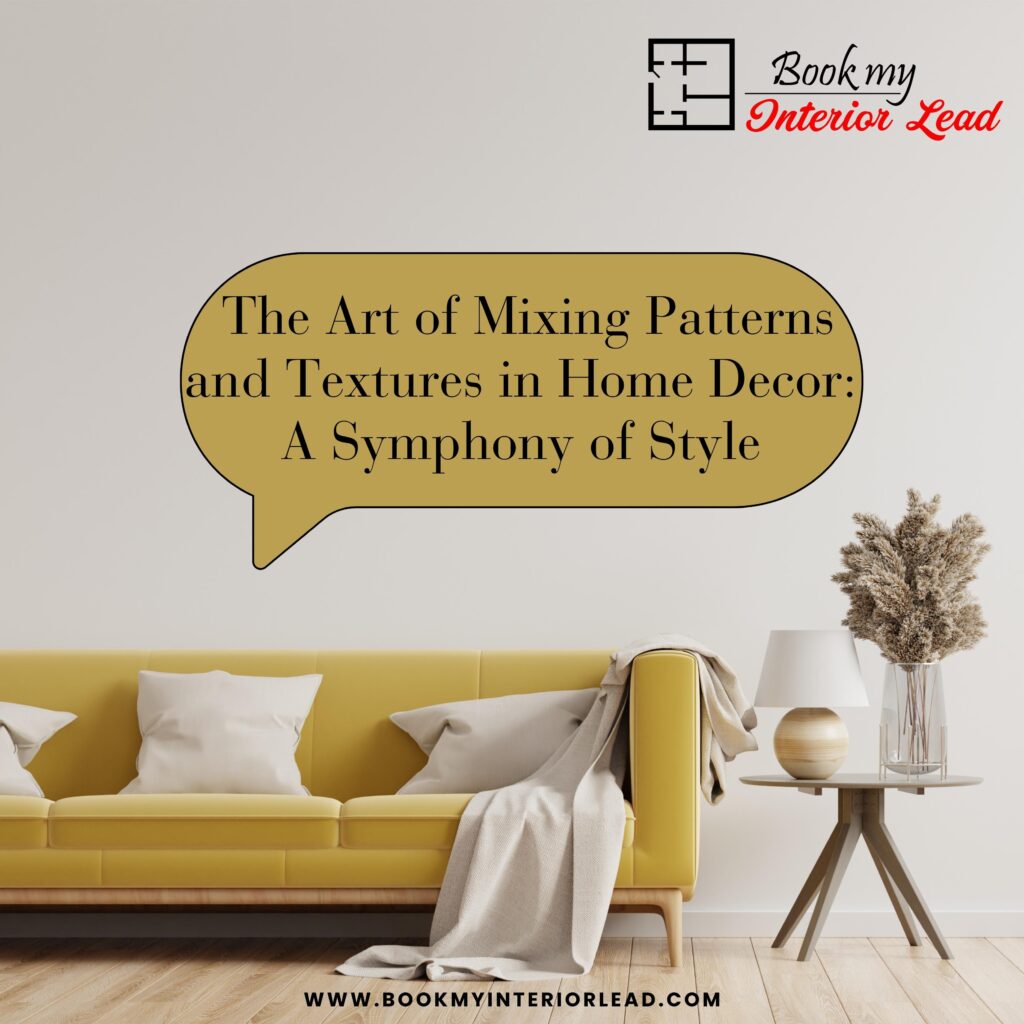Introduction:
Home decor is a canvas where the artful blending of patterns and textures transforms spaces into expressions of individuality and style. The interplay of various design elements creates a harmonious symphony that reflects the personality and taste of the inhabitants. In this blog, we delve into the intricacies of the art of mixing patterns and textures, exploring how interior designers masterfully navigate this creative landscape to achieve stunning and cohesive home aesthetics.
Section 1: Understanding Patterns and Textures
1.1 Patterns Defined: Patterns are visual motifs or designs created by repeating elements such as shapes, lines, or colors. They add personality and interest to a space, becoming a key component of interior design.
1.2 Textures Unveiled: Textures, on the other hand, refer to the tactile quality of surfaces. They can be smooth, rough, soft, or coarse, and they play a crucial role in creating visual depth and inviting touch into a room.
Section 2: The Importance of Pattern and Texture Mixing
2.1 Creating Visual Interest: The amalgamation of patterns and textures is an effective strategy for creating visual interest in a space. It prevents monotony and adds layers of complexity that captivate the eye.
2.2 Personalizing Spaces: Mixing patterns and textures allows homeowners to infuse their personality into their living spaces. It provides an opportunity to tell a unique story and create a home that feels distinctly their own.
2.3 Achieving Balance: Achieving a balance in pattern and texture mixing is key to successful interior design. Too much of one element can be overwhelming, while too little can result in a lackluster and uninspiring space.
Section 3: Navigating Pattern Mixing
3.1 Understanding Scale: One of the fundamental aspects of pattern mixing is understanding the scale of patterns. Combining patterns of varying sizes ensures a harmonious and visually balanced composition.
3.2 Coordinating Color Schemes: A cohesive color scheme is essential when mixing patterns. Whether complementary or contrasting, a well-coordinated color palette ties together disparate patterns, creating a unified look.
3.3 Embracing Pattern Types: Experimenting with different types of patterns, such as florals, geometrics, and stripes, adds diversity to the design. Playing with a mix of classic and contemporary patterns elevates the visual appeal.
Section 4: Mastering Texture Blending
4.1 Layering with Soft Furnishings: Soft furnishings like cushions, throws, and rugs are excellent tools for introducing varied textures. Layering these elements adds warmth and comfort to a room.
4.2 Incorporating Natural Elements: Natural textures, such as wood, stone, and woven materials, bring an organic quality to interior spaces. They contribute to a balanced design by introducing elements inspired by nature.
4.3 Playing with Contrasts: Contrasting textures, such as pairing a smooth leather sofa with a chunky knit throw, create a dynamic and inviting atmosphere. The juxtaposition of textures adds visual intrigue.
Section 5: Practical Tips for Interior Designers
5.1 Start with a Neutral Base: Begin with a neutral base to provide a foundation for pattern and texture mixing. This ensures that the overall design is cohesive and not visually overwhelming.
5.2 Experiment with Scale: Interior designers often experiment with patterns of different scales to create a layered and dynamic effect. A mix of large-scale and small-scale patterns adds visual interest.
5.3 Incorporate Statement Pieces: Introducing statement pieces, such as a boldly patterned rug or a textured accent wall, can serve as focal points that anchor the design and inspire the overall decor scheme.
Section 6: Trends in Pattern and Texture Mixing
6.1 Bohemian Eclecticism: The Bohemian style embraces an eclectic mix of patterns and textures, creating a vibrant and relaxed aesthetic. It often combines global influences, vintage finds, and rich textures for a maximalist look.
6.2 Modern Minimalism: Even in minimalist design, there is room for pattern and texture. Subtle geometric patterns, monochromatic textures, and carefully selected accents can add depth to a clean and modern space.
6.3 Scandinavian Simplicity: Scandinavian design often features a blend of simple patterns and natural textures. The emphasis is on functionality and a sense of calm, with muted colors and cozy textiles.
Section 7: Case Studies in Pattern and Texture Mastery
7.1 Mixing Patterns in a Bohemian Living Room: Explore how a bohemian living room incorporates an array of patterns, from ikat prints to intricate Persian rugs, creating a lively and eclectic ambiance.
7.2 Texture Blending in a Modern Bedroom: Delve into a modern bedroom where textures take center stage with a mix of sleek metallic finishes, plush textiles, and a variety of fabric patterns.
7.3 Harmonizing Patterns in a Scandinavian Kitchen: Discover a Scandinavian-inspired kitchen that achieves harmony by combining subtle patterns, such as herringbone tiles and geometric textiles, with natural textures like light wood and stone.
Section 8: The Role of Interior Designers in Pattern and Texture Mixing
8.1 Collaborating with Clients: Interior designers collaborate closely with clients to understand their preferences, ensuring that the selected patterns and textures align with the homeowner’s vision and lifestyle.
8.2 Curating a Cohesive Palette: A crucial aspect of a designer’s role is curating a cohesive color and texture palette. This involves selecting patterns and textures that work together harmoniously to create a unified design.
8.3 Balancing Boldness with Restraint: Experienced interior designers strike a balance between boldness and restraint when mixing patterns and textures. They know when to introduce statement pieces and when to allow for moments of simplicity.
Conclusion:
The art of mixing patterns and textures in home decor is a dynamic and creative process that elevates interiors from ordinary to extraordinary. Interior designers, armed with a deep understanding of color theory, scale, and texture, navigate this intricate landscape to create visually stunning and emotionally reson
